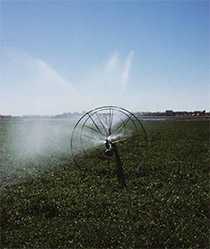NCEH State Fact Sheets: Iowa
CDC 24/7: Saving Lives. Protecting People from Health Threats. Saving Money through Prevention.
Environmental Health
 Your environment is everything around you—the air you breathe, the water you drink, the community around you, the places where your food is grown or prepared, your workplace, and your home. When your environment is safe and healthy, you are more likely to stay healthy. But when your environment exposes you to dangerous events or toxic substances, your health can be affected negatively.
Your environment is everything around you—the air you breathe, the water you drink, the community around you, the places where your food is grown or prepared, your workplace, and your home. When your environment is safe and healthy, you are more likely to stay healthy. But when your environment exposes you to dangerous events or toxic substances, your health can be affected negatively.
CDC is committed to saving lives and protecting people from environmental hazards by responding to natural and man-made disasters, supporting public health workers, educating communities, and providing scientific knowledge. We help maintain and improve the health of Americans by promoting a healthy environment and preventing premature death and avoidable illness caused by environmental and related factors. We also identify how people might be exposed to hazardous substances in the environment and assess exposures to determine if they are hazardous to human health. CDC invests in prevention to improve health and save money by reducing healthcare costs. We remain committed to maximizing the impact of every dollar entrusted to the agency.

Funded Activities
Core Environmental Health Services Program
(FY 2013 funding for Iowa—$118,000. FY 2014 funding information will be available later in the year.)
Foodborne and waterborne outbreaks result in millions of illnesses and thousands of deaths each year. They can cost the United States more than $150 billion annually.
Historically, clean drinking water systems have been responsible for reducing overall deaths in large cities by nearly one-half and child deaths by nearly two-thirds. Current estimated hospitalization costs for just three common waterborne diseases (Legionnaires’ disease, cryptosporidiosis, and giardiasis) in the United States are between $149 and $539 million per year.
CDC’s Core Environmental Health Services program is the only federal program that provides essential leadership and guidance to the nation’s frontline environmental health department staff.
CDC’s program
- Supports the professional development of environmental public health staff. This staff makes up 25% of the nation’s state, local, and tribal public health workforce and is essential to public health emergency response.
- Helps domestic water programs prevent waterborne diseases.
- Funds state and local health programs to investigate root causes of foodborne illness outbreaks.
- Responds rapidly to environmental disasters, including tornados, floods, foodborne and waterborne disease outbreaks, and control of vectorborne diseases.

Tracking
Beginning in August 2010, a 4-year grant from CDC allows IDPH to work with other state and local agencies and non-governmental organizations to develop and implement an Iowa Environmental Public Health Tracking Network. The Iowa Tracking Program implemented its state network in fall 2012.
Environmental Public Health Tracking Program
(FY 2013 funding for Iowa—$455,000. A new funding announcement has been released; FY 2014 funding information will be available later in the year.)
The World Health Organization (WHO) estimates that nearly 25% of all diseases are caused by environmental exposures. Some of these diseases—such as cancer, asthma, and cardiovascular disease—are the greatest killers today.
CDC’s Environmental Public Health Tracking Network (Tracking Network) is a dynamic web-based tool that tracks and reports environmental hazards and the health problems that may be related to them.
The Tracking Network’s integrated health, environmental exposure, and hazard information is used to
- Identify interventions and inform policies to reduce or prevent health effects from environmental exposures.
- Assess and research environmental links to diseases.
- Learn more about health and environmental issues in the communities where we live.
Since 2005, the Tracking Network has led to at least 160 public health interventions that prevent or control potential health effects from environmental exposures.
Lead Poisoning Prevention
(FY 2011 funding for Iowa—$594,000; because of funding reductions, the program was discontinued in 2012. Some funding was restored in FY 2014. States will be recompeting for funding and more information will be available later in the year.)
More than 12 million U.S. children are exposed to lead in their homes at levels which can harm their intellectual development. No safe blood level in children has been identified.
Reducing children’s lead exposure is perhaps the greatest environmental health accomplishment in the past 20 years.
For more than 20 years, CDC funded state and local health agencies to
- Support surveillance, training, and technical capacity that help identify children with dangerous exposure to lead.
- Connect these children and their families to appropriate health care and case management.
- Inspect and remediate unsafe homes.
Children who are exposed to lead lose $3,000 to almost $8,00 in lifetime productivity for each 1 microgram per deciliter (μg/dL) increase in blood lead level. Blood lead levels over 1 μg/dL are associated with measurable reductions in IQ.
Between 2007–2008 and 2009–2010, interventions that control or eliminate lead hazards before children are exposed (primary prevention), helped reduce the number of children exposed to lead (blood lead levels ≥ 1μg/dL) by nearly 3 million, saving $26–57 billion in lifetime productivity earnings alone. These estimates do not account for behavioral and other adverse effects on lifetime productivity linked to lead.
Safe Water Program
(FY 2013 funding for Iowa—$140,000. FY 2014 funding information will be available later in the year.)
About 15% of households in the United States get their drinking water from private wells and other unregulated sources where little is known about the quality of water.
The Safe Water Program prevents human exposure to and disease from infectious and non-infectious waterborne contaminants by
- Building state capacity to identify and address unregulated drinking water issues.
- Advancing the science to describe the health effects of drinking water contaminants.
- Promoting effective, evidence-based strategies to prevent exposure to drinking water contaminants.
- Improving capacity to respond to environmental emergencies that affect water.
Public Health in Action

Core Environmental Health
The Cerro Gordo County Department of Public Health is working on a water practice project to determine the source of arsenic found in the county’s groundwater.
From: http://www.cdc.gov/nceh/ehs/
EHSNet/partners/cerro-gordo.htm
Arsenic Contamination in Cerro Gordo County
CDC’s Environmental Health Specialist Network (EHS-Net) is a collaboration among environmental health specialists, epidemiologists, and laboratorians aimed at preventing illness and outbreaks related to environmental hazards in food and water.
EHS-Net is working in Cerro Gordo County, Iowa to understand arsenic contamination of the county’s well water. Some regions of the United States have high levels of naturally occurring arsenic in groundwater. Exposure to dangerous levels of arsenic can be hazardous to human health. Its effects include arsenic poisoning, damage to major organ systems, reproductive health problems, and cancer. EHS-Net’s efforts aim to
Tracking Pesticide Use in Iowa
Private water wells can be contaminated by pesticides, especially in farming areas. Contact with pesticides may be related to a variety of acute and chronic health problems. About 15% of Iowans use private wells for drinking water. The Iowa Tracking Program helps identify areas with high pesticide use and monitors those areas for health problems related to pesticides. This is done in collaboration with the State Hygienic Laboratory and the Iowa Department of Agriculture and Land Stewardship to map off-label pesticide use, pesticide sales, pesticide application statistics, and private well contamination data. This work helps improve the state’s ability to measure pesticide exposure and helps the Iowa Department of Public Health to determine if education, intervention programs, regulations, or guidelines are needed for monitoring drinking wells.
Tracking Nitrates and Cancer in Iowa
Nitrate contamination of drinking water often is found in farming areas, usually from fertilizer runoff and human and animal waste. Some studies in Iowa have suggested a link between nitrate exposure and cancer. The Iowa Tracking Program will make private and public water supply data and cancer data available to explore possible links between nitrates in drinking water and cancer. Being able to link water and cancer data may help show associations between health effects data and nitrate contamination data. Further scientific evidence will help to create nitrate management policies and public education materials.
Lead Poisoning Prevention in Iowa*
The following describes activities carried out in previous years with the support of CDC’s Lead Poisoning Prevention Program when it was fully funded:

Lead
- Of children ages 6 and under who were tested for blood lead in Iowa in 2011, 30,852 children had elevated blood lead levels (5 μg/dL or greater).
- *CDC’s funding to state lead poisoning prevention programs was eliminated in FY 2012 because of budget reductions.
CDC funding supported Iowa’s Childhood Lead Poisoning Prevention Program (CLPPP) in its efforts to reduce unsafe lead levels among children under age 6. The state passed legislation in 2008 that requires all children entering kindergarten to be tested for lead poisoning. Iowa’s CLPPP monitors compliance with the requirement and follows up with children who have not been tested.
Most of the pre-1950s homes in the state contain lead-based paint, which comes into contact with young children through contaminated soil, dust, and paint chips. The statewide program provides technical assistance to Title V child health clinics and public health agencies in 71 counties, as well as direct services in 28 counties. Iowa’s CLPPP
- identifies children with elevated blood lead levels through testing,
- assists with case management,
- educates communities about childhood lead poisoning,
- involves community leaders in lead poisoning prevention, and
- manages blood lead testing and case management data.
Partners include local health departments, Title V child health clinics, health care providers, area education agencies, and housing agencies.
The state also collects data on blood lead levels of Iowans over the age of 16 through the Adult Blood Lead Epidemiology and Surveillance (ABLES) program. The program conducts interventions for adults with blood lead levels greater or equal to 25 μg/dL by sending information, conducting phone interviews, and working with individuals and workplaces to reduce lead exposure. On several occasions, ABLES also identified cases where children were exposed to lead due to their parents’ exposure in the workplace.
Iowa’s Lead Professional Certification Program provides training and certification of lead professionals, including lead inspectors, risk assessors, lead abatement contractors, and renovators. The program assures that lead professionals properly and safely identify and eliminate lead hazards. As of 2009, almost 6,000 workers had completed a lead-safe work practices training program. In addition, Iowa’s CLPPP provides comprehensive training to child care providers on lead-based paint hazards.
- Page last reviewed: April 30, 2014
- Page last updated: April 30, 2014
- Content source:


 ShareCompartir
ShareCompartir